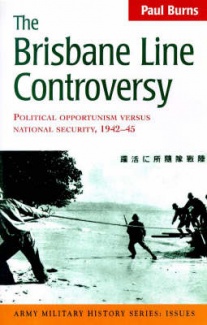A testament to hot hardened air turning into fact. The bigger the lie, the more it is repeated, the more likely it is to be believed.

In short, there was no such thing. But the reality that underlay the political point scoring, with the barbarians at the gate, was the tension between military strategy and political possibility.
Any general looking at a map of Australia in one hand and a list of armed forces available in 1941 or 1942 would have seen the obvious. (1) The whole continent cannot be defended and (2) the whole continent need not be defended to keep Australia in the war. As to (1) there were too few troops and material to defend every inch of the Australian coast. Moreover, (2) to stay in the war the bulk of the population and the industrial heartland had to be defended – Sydney and Melbourne were the core of that no matter what else might be said.
Yet no politician could say (2) and so every politician had to deny (1). The Australian general staff never articulated a Brisbane Line, though at various times officers would study maps and pick places where defensive lines would be best placed, usually a ridge line with roads behind it, protecting major centres of population. The implication is that if a backbencher’s constituency is on the far side of that line, that territory is conceded. That is the bounce of the political football.
Timing is important here. When the conservative parties governed early in World War II, Japan, though allied with Germany and Italy, had not entered the war. Though there was speculation that it would and then pose a threat to Australia so some army staff work did consider this possibility. By the time Japan entered the War in December 1941 the Curtin Labor government was in office, and it faced the reality of a Japanese threat.
Though some dismissed this threat as impossible on logistic grounds, the Japanese had already done several logistically impossible things, like attack Pearl Harbor, overrun the Malay Peninsula, and then capture Singapore.
Eddie Ward, a minor Labor cabinet minister, and full-time firebrand heard rumours of a defensive line that conceded much of the continent to an enemy invasion from the north. Once he had that he did not let go. He blamed it on the previous conservative government and railed against it, though as he himself admitted more than once there was no documentary evidence that such a plan ever existed. Like George W. Bush’s Weapons of Mass Destruction, Ward supposed that the absence of evidence was not evidence of absence.
To maintain trust with the opposition conservative parties who were cooperating in a War Council, Prime Minister Curtin created a royal commission to look for evidence, which the conservatives were confident did not exist, and to distance himself (Curtin) from Ward’s increasingly reckless assertions. The royal commissioner found no evidence of a planned Brisbane Line in cabinet papers and no indication that anything had been removed. Nothing, nada, nil.
Yet Eddie Ward continued to bang that drum and when Labor won the 1943 election he took credit for it, and kept banging on. Curtin continued to stay away from him but the redoubtable Jack Lang, ever a thorn in the side of anyone nearby, promulgated Ward’s baseless assertion and it became an article of faith, like immaculate conception, in some Labor Party circles, so that in the 1993 election when the incumbent Labor Prime Minister Paul Keating pulled all the stops (when did he not) he dredged it up as a fact to smear by party affiliation his then opponent. The living dead indeed.
Someone told me of the Brisbane Line as fact many years ago and I took it on faith, coupled with the assertion that there was a supplementary plan to evacuate Canberra to a communications centre in Hay, NSW. While the Brisbane Line has a genealogy in Eddie Ward’s crazed demonology, I can find nothing at all to link Hay to it, which was the site of a very large and diverse (Italian, German, and Japanese) prisoner of war camp at the time and that would have surely meant it was not the place for an important military facility. My forgotten informant got that wrong also, and credulous me believed, untested, for all these years.
The book is not recommended for reading pleasure. It is garbled, poorly edited, full of incomprehensible acronyms, curiously abstract preferring the nominalism of military command structures that seemed to change month-by-month without any indication of manpower, and pointlessly pedantic on trivial matters. Yet it is the only monograph I could find on the subject.
